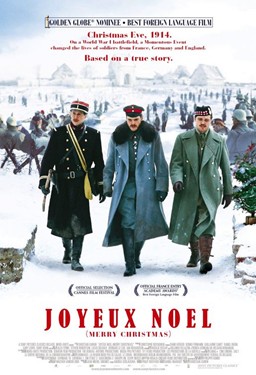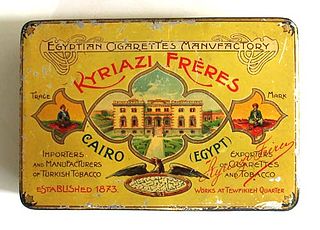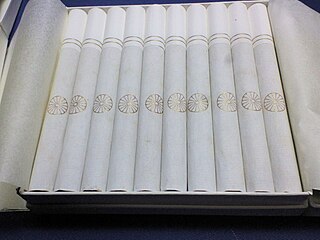
The Princess Mary Christmas gift box was a brass tin containing a number of gifts intended to be distributed to all members of the armed forces of the British Empire on Christmas day 1914, during World War I. [1] [2]

The Princess Mary Christmas gift box was a brass tin containing a number of gifts intended to be distributed to all members of the armed forces of the British Empire on Christmas day 1914, during World War I. [1] [2]
Following the outbreak of the First World War in August 1914, the British Expeditionary Force was sent to the Western Front and was soon joined by troops from the Empire, those from India arriving before the end of the year. [3] On 14 October 1914, George V's 17-year-old daughter, Mary, Princess Royal, launched an appeal to fund a Christmas gift for every member of the armed forces. [4] [5] Shortly before Christmas 1914, advertisements were placed in the British press seeking donations for the "Soldiers and Sailors Christmas fund" and £152,691 was soon raised. [6] When fund was wound up in 1920 the remaining funds were transferred to Queen Mary's Maternity Home. [5]

The funding was used to manufacture small boxes made of brass; however, due to metal shortages in the later stages of the war some tins were made from plated base metals or alloys. [6] Each tin was decorated with an image of Mary and other military and imperial symbols along with the names of the UK's then allies. [5] The design was by Stanley Adshead and Stanley Ramsey. [5] Obtaining enough brass strip to make the boxes remained a continual problem, a situation not helped when a large consignment from the US was lost due to the sinking of the RMS Lusitania. [5] Not all the items would fit in the brass box, so the collective gift including the brass box was contained and distributed in a cardboard box. [7]
A set of dies used to make the boxes was donated to the Imperial War Museum by Princess Mary. [5]
The standard gift (referred to as the smokers gift in some post war publications) consisted of the box itself, twenty cigarettes in a yellow monogrammed wrapper, an ounce of pipe tobacco, a pipe, a Christmas card and a photograph of Princess Mary. [5] [8] [9] It was meant to also include a tinder lighter, but a shortage of these meant that in the case of the army they were often substituted with other gifts and those in the navy received a bullet pencil. [5] The bullet pencil consisted of a silver tipped pencil (either Stirling silver of nickel silver) in a case made from a spent .303 cartridge recovered from UK firing ranges and marked with an M. [10]
A non-smokers gift was also produced at a ratio of 1 for every 28 smokers gifts. [5] It consisted of the box, Christmas card and photograph of Princess Mary, [5] but also, instead of smoking related materials it contained a packet of "acid tablets" (a type of sour lemon flavoured sweet) and a khaki writing case with pencil, paper and envelopes. [5] [11]

Three further gift types were produced for Indian troops. [5] Most Indian troops received the box itself, cigarettes, a tin box of spices, a packet of sugar candy and a Christmas or New Year card. [5] Sikhs got the same without the cigarettes and a third gift for "followers" [note 1] consisted of a tin box of spices and a Christmas or New Year card. [5]
A version was also produced for nurses. [5] It consisted of, again, the box itself, a packet of chocolate and the usual Christmas or New Years card. [5]
With the aim of every man at the front and every man on Royal Navy ships getting a gift having been met by 5 January 1915, attention was turned to the remaining forces ultimately under British command (classified as class B and C by the committee). [5] For these, it was decided that the gift would consist of the box, a New Year card and a pencil. [5]
The boxes were originally intended for "every sailor afloat and every soldier at the front" on Christmas day 1914, [13] but eligibility was soon extended to everyone "wearing the King's uniform on Christmas day". [6] Whilst around 400,000 were delivered by Christmas, distribution was not completed until 1920, by which time approximately 2.5 million had been delivered. [6]

Cigarette cards are trading cards issued by tobacco manufacturers to stiffen cigarette packaging and advertise cigarette brands.

The C-ration was a United States military ration consisting of prepared, canned wet foods. They were intended to be served when fresh or packaged unprepared food was unavailable, and survival rations were insufficient. It was replaced by the similar Meal, Combat, Individual (MCI) in 1958; its modern successor is the Meal, Ready-to-Eat (MRE).

Craven A(stylized asCraven "A") is a British brand of cigarette, currently manufactured by British American Tobacco under some of its subsidiaries. It was originally created by the Carreras Tobacco Company in 1921 and made by them until its merger into Rothmans International in 1972, who then produced the brand until Rothmans was acquired by British American Tobacco in 1999.

The Christmas truce was a series of widespread unofficial ceasefires along the Western Front of the First World War around Christmas 1914.

Lucky Strike is an American brand of cigarettes owned by the British American Tobacco group. Individual cigarettes of the brand are often referred to colloquially as "Luckies."

W.D. & H.O. Wills was a British tobacco manufacturing company formed in Bristol, England. It was the first British company to mass-produce cigarettes, and one of the founding companies of Imperial Tobacco along with John Player & Sons.

United States military ration refers to the military rations provided to sustain United States Armed Forces service members, including field rations and garrison rations, and the military nutrition research conducted in relation to military food. U.S. military rations are often made for quick distribution, preparation, and eating in the field and tend to have long storage times in adverse conditions due to being thickly packaged or shelf-stable.

A field dressing or battle dressing is a kind of bandage intended to be carried by soldiers for immediate use in case of wounds. It consists of a large pad of absorbent cloth, attached to the middle of a strip of thin fabric used to bind the pad in place. Field dressings are issued in sealed waterproof pouches to keep them clean and dry; the pouch can be torn open when required.

Joyeux Noël is a 2005 war drama film based on the Christmas truce of December 1914, depicted through the eyes of French, British, and German soldiers. It was written and directed by Christian Carion, and screened out of competition at the 2005 Cannes Film Festival.

The .577/450 Martini–Henry is a black powder, centrefire rifle cartridge. It was the standard British service cartridge from the early 1870s that went through two changes from the original brass foil wrapped case to the drawn brass of two parts, the case and the primer. The .577/450 Martini–Henry was introduced with the Martini–Henry, in service it succeeded the .577 Snider cartridge and was used by all arms of the British armed forces as well British colonial forces throughout the British Empire until it was itself succeeded by the .303 British cartridge after an unsuccessful trial of a .402 calibre.
Woodbine is a British brand of cigarettes which, as of 2019, is owned and manufactured by Imperial Tobacco. Woodbine cigarettes are named after the woodbine flowers, native to Eurasia.

A pack or packet of cigarettes is a rectangular container, mostly of paperboard, which contains cigarettes. The pack is designed with a flavor-protective foil, paper or plastic, and sealed through a transparent airtight plastic film. By pulling the "pull-tabs", the pack is opened. Hard packs can be closed again after opening, whereas soft packs cannot.
A Tommy cooker was a compact, portable stove, fuelled by a substance referred to as "solidified alcohol" which was issued to British troops ("Tommies") in World War I. It was notoriously ineffective; one soldier complained that it took two hours to boil half a pint of water. A variety of commercial or improvised alternatives were in use.

The 7th Dragoon Guards was a cavalry regiment in the British Army, first raised in 1688 as Lord Cavendish's Regiment of Horse. It was renamed as the 7th Dragoon Guards for Princess Charlotte in 1788. It saw service for two centuries, including the First World War, before being amalgamated with the 4th Royal Irish Dragoon Guards, to form the 4th/7th Dragoon Guards in 1922.
Army Club was a British brand of cigarettes, owned and manufactured by Cavanders Ltd of London.

The Egyptian cigarette industry, during the period between the 1880s and the end of the First World War, was a major export industry that influenced global fashion. It was notable as a rare example of the global periphery setting trends in the global center in a period when the predominant direction of cultural influence was the reverse, and also as one of the earliest producers of globally traded manufactured finished goods outside the West.

The British Army used a variety of standardized battle uniforms and weapons during World War I. According to the British official historian Brigadier James E. Edmonds writing in 1925, "The British Army of 1914 was the best trained best equipped and best organized British Army ever sent to war". The value of drab clothing was quickly recognised by the British Army, who introduced Khaki drill for Indian and colonial warfare from the mid-19th century on. As part of a series of reforms following the Second Boer War, a darker khaki serge was adopted in 1902, for service dress in Britain itself. The British military authorities showed more foresight than their French counterparts, who retained highly visible blue coats and red trousers for active service until the final units received a new uniform over a year into World War I. The soldier was issued with the 1908 Pattern Webbing for carrying personal equipment, and he was armed with the Short Magazine Lee–Enfield rifle.

Onshi no tabako (恩賜のたばこ) or Onshitabako (恩賜煙草) were the packets of cigarettes given out by the Japanese emperor. There were other kinds of special tobacco for relatives of the emperor and members of the Imperial Household. The production of the former came to an end in 1945. The production of Onshino Tabako finally ceased at the end of 2006, the last producer being the Japan Tobacco Company.

Navy Cut Tobacco is a defunct brand of cigarettes, originally manufactured by Imperial Brands – formerly John Player & Sons – in Nottingham, England. The brand became "Player's Navy Cut". They were particularly popular in Britain, Germany and British Ceylon in the late 19th century and early part of the 20th century and were later produced in the United States. The packet has the distinctive logo of a sailor in a 'Navy Cut' cap.

Stanley Churchill Ramsey was a British architect, who worked in partnership with Stanley Davenport Adshead from 1911 to 1931. In 1911, Adshead was invited to design the Duchy of Cornwall Estate in Kennington, and took Ramsey into partnership. In addition to architecture the partnership also designed the brass box of the Princess Mary Christmas gift box.